A Yellow Perennial Garden - Details
- Front
- Rear - Succulents
Site Plan |
Plants |
Sources |
Failures |
Bloom Times |
Soils |
Wildlife |
Weather
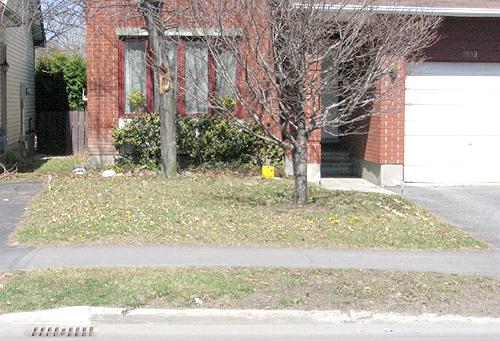 2005: Moving in date was just before the ground was frozen solid. Some crocus bulbs were
quickly added to the front lawn and narcissus to the back. A few weeks later, a weak fork of the
Prunus virginiana in the front snapped off in an ice storm, leaving a gaping wound and seriously
weakening a second fork. The second fork was shortened by 1/3 to reduce stress on it. The tree
lost almost half its leaf area.
2005: Moving in date was just before the ground was frozen solid. Some crocus bulbs were
quickly added to the front lawn and narcissus to the back. A few weeks later, a weak fork of the
Prunus virginiana in the front snapped off in an ice storm, leaving a gaping wound and seriously
weakening a second fork. The second fork was shortened by 1/3 to reduce stress on it. The tree
lost almost half its leaf area.
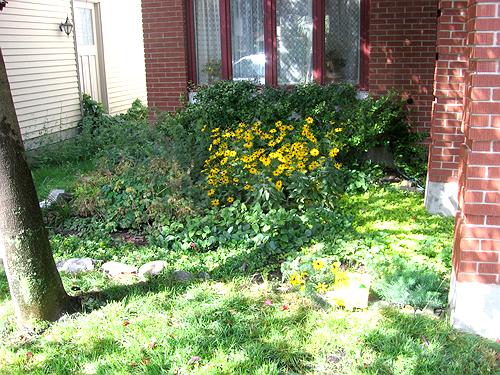 2006: Tree roots from the back third of the front lawn were cut off and dug out, which
helped a bit to balance the damaged Prunus top with its roots, and experiments with plants started.
A "free plants" sign and the offer of all the non-yellow flowers that appeared made friends with
neighbouring gardeners and resulted in many plants in exchange. The frantic blast of water sprouts
from the wounded tree were kept under control. A small preformed pond, several berry shrubs, and
bird feeders were added to the rear yard to attract birds and small mammals. A
compost bin was built.
2006: Tree roots from the back third of the front lawn were cut off and dug out, which
helped a bit to balance the damaged Prunus top with its roots, and experiments with plants started.
A "free plants" sign and the offer of all the non-yellow flowers that appeared made friends with
neighbouring gardeners and resulted in many plants in exchange. The frantic blast of water sprouts
from the wounded tree were kept under control. A small preformed pond, several berry shrubs, and
bird feeders were added to the rear yard to attract birds and small mammals. A
compost bin was built.
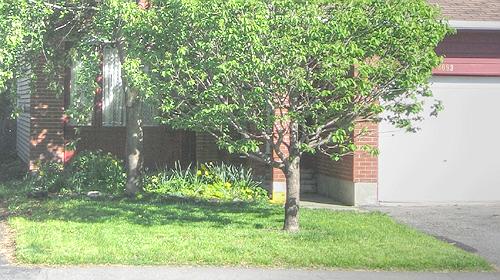 2007: More plants were introduced for trial. Repairs continued on the Prunus to nurse it
back to health.
2007: More plants were introduced for trial. Repairs continued on the Prunus to nurse it
back to health.
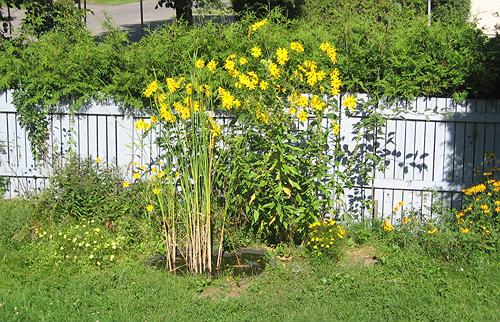 A meadow of native yellow-flowering plants was begun along the back fence.
A meadow of native yellow-flowering plants was begun along the back fence.
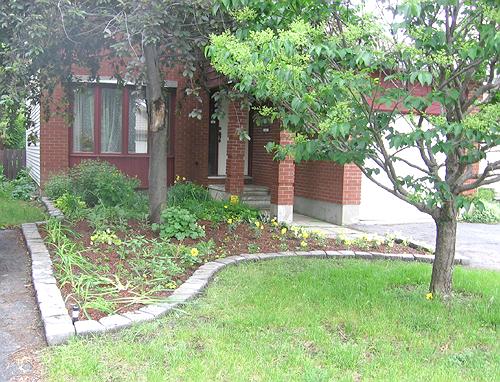 2008: I and the plants were settled in enough that the front garden was expanded to fill
the middle third using material that had proven successful during the first two years. A low rock
curb that matched the new interlock driveway was installed to give shape to it. A new garden was
begun in a rear shady corner, and a roof-watered
bog garden built under the cedar trees at the back with the help of
son Arthur. A sprinkler system was added for use during Ottawa's usual extended summer drought.
(It may be early or late, but we almost always get one.)
2008: I and the plants were settled in enough that the front garden was expanded to fill
the middle third using material that had proven successful during the first two years. A low rock
curb that matched the new interlock driveway was installed to give shape to it. A new garden was
begun in a rear shady corner, and a roof-watered
bog garden built under the cedar trees at the back with the help of
son Arthur. A sprinkler system was added for use during Ottawa's usual extended summer drought.
(It may be early or late, but we almost always get one.)
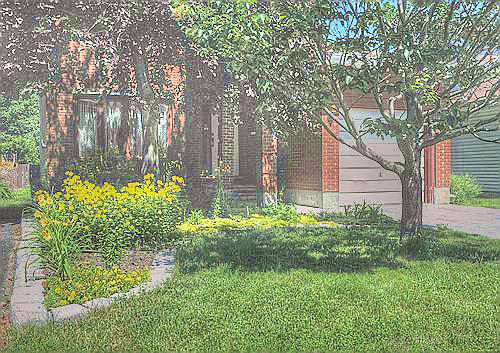 2009: Conversion of the back fence meadow to a garden was
begun. Deep digging was the order of the day to get rid of Convolvulus arvensis roots that the
previous owner had allowed to become endemic throughout the back yard. Part of a concrete patio
was converted to an alpine garden, and another garden added on
the east side of the house. The Syringa tree at the front lost
half its branches over the winter, didn't produce any new shoots to replace lost branches, and
dropped its leaves early.
2009: Conversion of the back fence meadow to a garden was
begun. Deep digging was the order of the day to get rid of Convolvulus arvensis roots that the
previous owner had allowed to become endemic throughout the back yard. Part of a concrete patio
was converted to an alpine garden, and another garden added on
the east side of the house. The Syringa tree at the front lost
half its branches over the winter, didn't produce any new shoots to replace lost branches, and
dropped its leaves early.
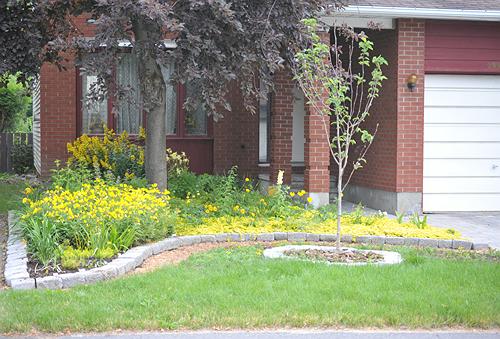 2010: Early spring, a Magnolia 'Yellow Bird' was installed in the front garden to replace
the failed Syringa. During the summer, the rotting railway tie wall at the back was dug out and
replaced by interlocked stone, non-toxic and permanent. The back fence was repaired with help from
son Michael. After a lifetime of doing my own composting, I switched
to the city's green bin program, making more space for flowers of course. Finally, the
fence garden was structurally complete. Late fall, emboldened by
the frequency with which I received compliments from neighbours while working in the garden, the
remaining grass in the front (back of the sidewalk) was replaced by sedum, crocus and narcissi.
2010: Early spring, a Magnolia 'Yellow Bird' was installed in the front garden to replace
the failed Syringa. During the summer, the rotting railway tie wall at the back was dug out and
replaced by interlocked stone, non-toxic and permanent. The back fence was repaired with help from
son Michael. After a lifetime of doing my own composting, I switched
to the city's green bin program, making more space for flowers of course. Finally, the
fence garden was structurally complete. Late fall, emboldened by
the frequency with which I received compliments from neighbours while working in the garden, the
remaining grass in the front (back of the sidewalk) was replaced by sedum, crocus and narcissi.
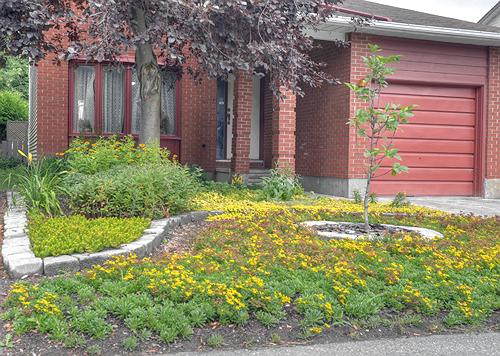 2011: The Magnolia 'Yellow Bird' died over the winter, and was replaced by a M.'Sunburst'.
A height extension and vines were added to the top of the fence of the back
shade garden for more privacy, the rear concrete patio was
replaced with natural slate stone, and an Aquilegia garden
built in the long-wasted area to the left of the
rear stairs. Despite one of the cloudiest summers I can remember, percent
sun contours were measured throughout the gardens. There were many more insect infestations
this year than usual, in particular of Monostegia abdominalis larvae in the front garden.
2011: The Magnolia 'Yellow Bird' died over the winter, and was replaced by a M.'Sunburst'.
A height extension and vines were added to the top of the fence of the back
shade garden for more privacy, the rear concrete patio was
replaced with natural slate stone, and an Aquilegia garden
built in the long-wasted area to the left of the
rear stairs. Despite one of the cloudiest summers I can remember, percent
sun contours were measured throughout the gardens. There were many more insect infestations
this year than usual, in particular of Monostegia abdominalis larvae in the front garden.
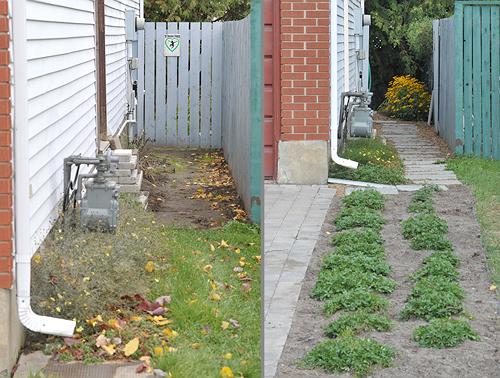 Limestone stepping stones were installed on the east side of
the house and planting completed.
Limestone stepping stones were installed on the east side of
the house and planting completed.
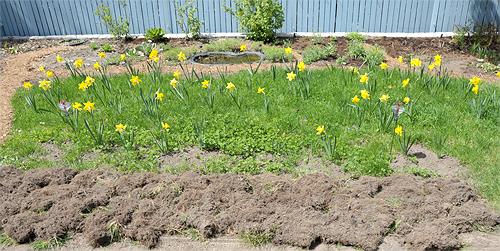 The last of the rear grass was replaced by a bulb garden and
extended patio. In the front all that remains in grass is the salt-saturated patch between sidewalk
and street, and I'm trying to establish Lotus corniculatus even there (despite the conditions being
perfect for Plantago major).
The last of the rear grass was replaced by a bulb garden and
extended patio. In the front all that remains in grass is the salt-saturated patch between sidewalk
and street, and I'm trying to establish Lotus corniculatus even there (despite the conditions being
perfect for Plantago major).
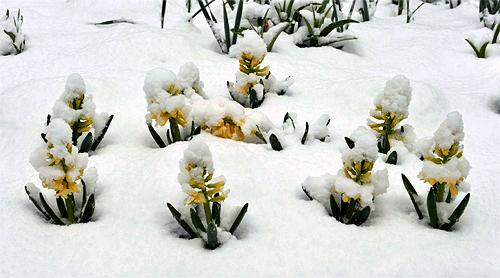 2012: 45 days after the first crocus was in bloom, the hyacinths were covered in wet snow.
They survived, so they'd belong here if they had stayed yellow. Unfortunately they got whiter each
year, so I gave them away. (3 week gaps between the last and 2nd-to-last spring frost
are common here; in 1957, the gap was over 4 weeks.) The weather upset Narcissus though,
only 10% of them bloomed. That was followed by a hot 26 June-22 July with no rain
whatsoever. (1995 was worse, and 1944 much worse; it too is part of weather here.) An
insect survey was done in the back gardens. The growth in numbers
of ichneumon wasps and other caterpillar and aphid predators was sufficient that the problem
insects of last year were nearly absent this year. Hemerocallis 'Stella d'Oro' was divided and
spread along the west side of the house.
2012: 45 days after the first crocus was in bloom, the hyacinths were covered in wet snow.
They survived, so they'd belong here if they had stayed yellow. Unfortunately they got whiter each
year, so I gave them away. (3 week gaps between the last and 2nd-to-last spring frost
are common here; in 1957, the gap was over 4 weeks.) The weather upset Narcissus though,
only 10% of them bloomed. That was followed by a hot 26 June-22 July with no rain
whatsoever. (1995 was worse, and 1944 much worse; it too is part of weather here.) An
insect survey was done in the back gardens. The growth in numbers
of ichneumon wasps and other caterpillar and aphid predators was sufficient that the problem
insects of last year were nearly absent this year. Hemerocallis 'Stella d'Oro' was divided and
spread along the west side of the house.
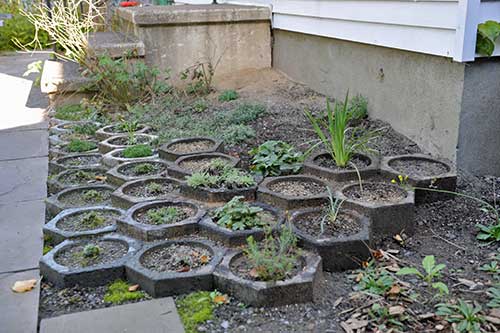 2013: A dozen different alpine plants were added to the gravel garden for trial, and
experimental hexagonal hypertufa pots cast to show them off. The
rear shade garden was disrupted by the addition of a new basement window. Half of the Sedum
hybridum in the geophyte garden was replaced by Ranunculus repens cuttings. Due to poorer bloom
than the Forsythia 'Northern Gold', the F.'Ottawa' was donated to another gardener.
2013: A dozen different alpine plants were added to the gravel garden for trial, and
experimental hexagonal hypertufa pots cast to show them off. The
rear shade garden was disrupted by the addition of a new basement window. Half of the Sedum
hybridum in the geophyte garden was replaced by Ranunculus repens cuttings. Due to poorer bloom
than the Forsythia 'Northern Gold', the F.'Ottawa' was donated to another gardener.
2014: The winter was harsh (-37C) and a dozen plants were lost. The magnolia was
removed after its infestation of scale proved impossible to handle. The first winter's survivors
of hexagonal pots and a second year's production were installed and the surviving alpines planted
in them, also some new ones. Parthenocissus tricuspidata 'Vetchii' was added to the west wall as
an experiment. The chokecherry showed clear signs of black knot fungus (Apiosporina morbosa),
which means that a replacement must be planned for.
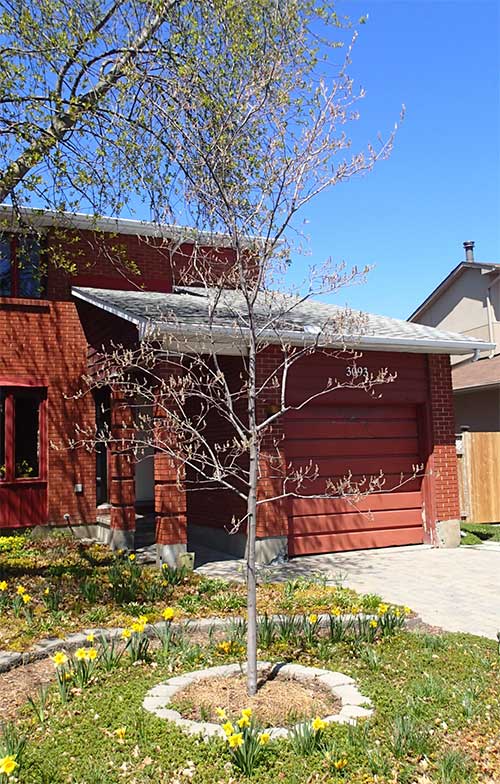 2015: The frost penetration was much deeper than usual, freezing hundreds of pipes
throughout Ottawa, almost wiping out local ground nesting bees and small Hymenoptera, and almost
killing the Parthenocissus tricuspidata 'Robusta'. An Amelanchier alnifolia was added to
the front to become a replacement for the chokecherry.
2015: The frost penetration was much deeper than usual, freezing hundreds of pipes
throughout Ottawa, almost wiping out local ground nesting bees and small Hymenoptera, and almost
killing the Parthenocissus tricuspidata 'Robusta'. An Amelanchier alnifolia was added to
the front to become a replacement for the chokecherry.
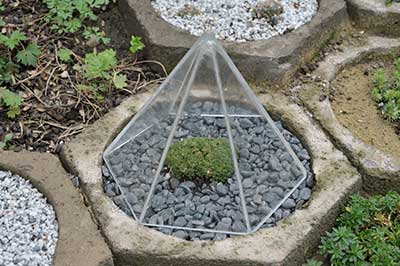 2016: The winter wiped out all the Aquilegia so it had to come up from seed, and set back
the Lilium, but other plants
thrived to compensate. The Forsythia 'Northern Gold' was donated to another gardener since it
grew too large and untidy for the site; a few Hemerocallis were donated to our first
neighbourhood Free Plant Exchange to focus on the happiest ones. The alpine pots were completed
along with trial acrylic tents for alpines that easily rot under snow, and experiments started
there with hardy cacti.
2016: The winter wiped out all the Aquilegia so it had to come up from seed, and set back
the Lilium, but other plants
thrived to compensate. The Forsythia 'Northern Gold' was donated to another gardener since it
grew too large and untidy for the site; a few Hemerocallis were donated to our first
neighbourhood Free Plant Exchange to focus on the happiest ones. The alpine pots were completed
along with trial acrylic tents for alpines that easily rot under snow, and experiments started
there with hardy cacti.
2017: Something, probably a cottontail, ate the bottom half-meter of every one of the
Parthenocissus over the winter. With TLC they're recovering, but herbivore guards are going
to be needed from now on.
2018: This was a terrible winter for losses: half the alpines, several Lilium, the Eremurus...
But worst of all, every scrap of the Parthenocissus above ground was killed, and my
treasured 'Robusta' lost totally.
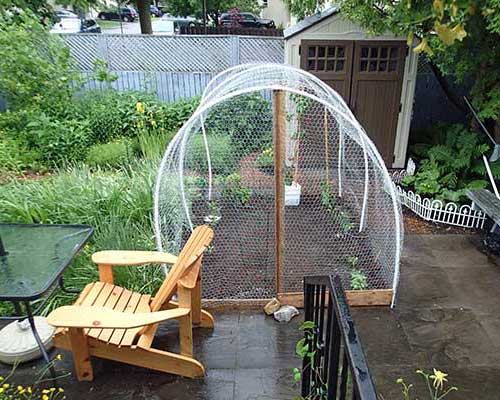 2019: Marriage in March resulted in the appearance of non-yellow flowers, and a
rodent-protected vegetable/fruit garden and storage shed being added to the back garden.
Half the space in the protected garden is for hardy self-fertile berry shrubs and grape vines,
the rest for herbs and annual veggies.
2019: Marriage in March resulted in the appearance of non-yellow flowers, and a
rodent-protected vegetable/fruit garden and storage shed being added to the back garden.
Half the space in the protected garden is for hardy self-fertile berry shrubs and grape vines,
the rest for herbs and annual veggies.
2020: First crops were obtained from several of the berry shrubs and one grape vine.
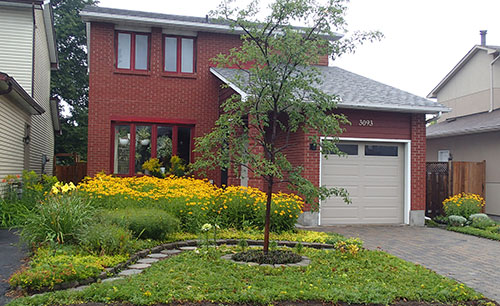 2021: The chokecherry reached the end of its life and was removed. The stump will be used
for ivy in a decorative pot. The front garden was awarded a city-wide prize:
2021: The chokecherry reached the end of its life and was removed. The stump will be used
for ivy in a decorative pot. The front garden was awarded a city-wide prize:
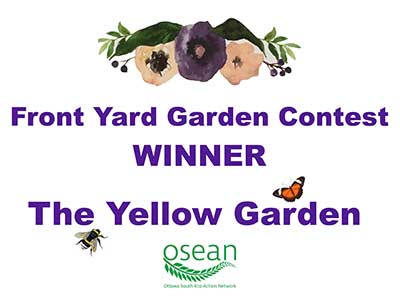
Site Plan

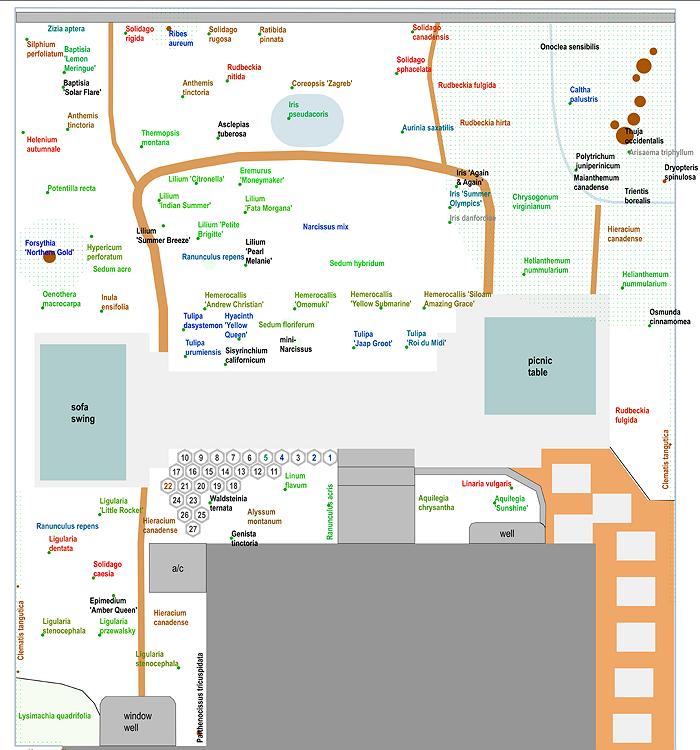
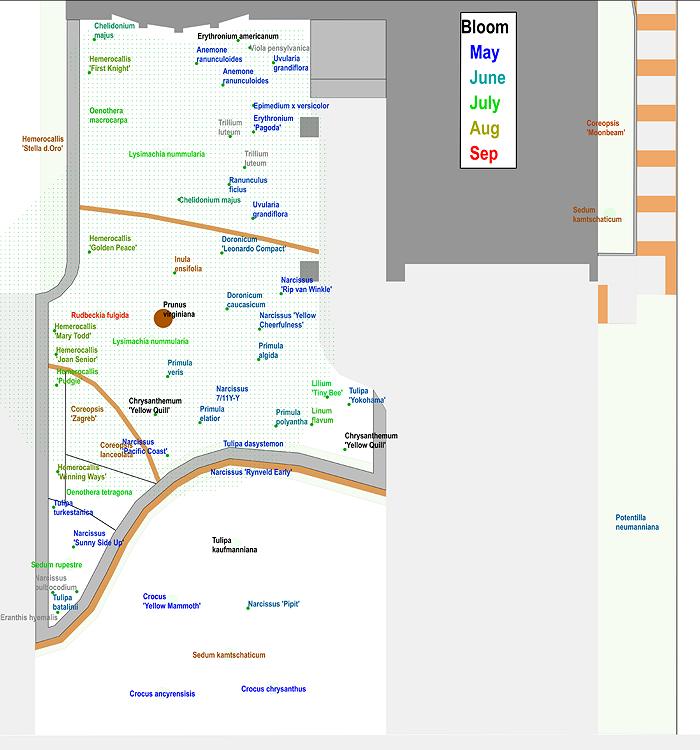
Perennial Plants (* experimental)
Achillea tomentosa Pursh non L.
Allium moly L.
Alyssum montanum L.
Anemone ranunculoides L.
Anthemis tinctoria L.
Aquilegia chrysantha A.Gray
Aurinia saxatilis (L.)Desv.
Baptisia 'Solar Flare': Ault 2009
Chelidonium majus L.
Clematis tangutica (Maxim.)Korsh.
Chrysogonum virginianum L.
Coreopsis verticillata L. 'Moonbeam'
Coreopsis verticillata L. 'Zagreb'
Coreopsis 'Golden Sphere'
Corydalis lutea (L.)DC.
Crocus ancyrensis (Herb.)Maw
Crocus chrysanthus Herb.
Crocus 'Yellow Mammoth': 1765
Delosperma nubigenum
Digitalis grandiflora Mill.
Doronicum caucasicum M.Bieb.
Draba acaulis Boiss.
Draba aizoides L.
Draba bruniifolia olympia Stev.
Draba compacta Schott Kotschy
Draba cuspidata M.Bieb.
Draba 'Judy': Judy Wall 2012
Draba mollissima Steven
Draba rigida Willd.
Draba 'Simon': Wrightman 2012
Echinacea 'Balsomemy': Darwin Perennials 2014
Epimedium 'Amber Queen': White 2010
Epimedium ×versicolor Morren
Erigeron aurantiacus 'Copper Elf'
Eriogonum umbellatum porteri (Small)S.Stokes
Erythronium americanum Ker.
Erysimum kotschyanum J.Gay
Euphorbia cornigera Boiss.
Euphorbia polychroma A.Kern.
Genista tinctoria 'Plena' L.
Helenium autumnale L.
Helianthemum nummularium (L.)Mill.
Helianthus strumosus L. &allies
Hemerocallis 'Andrew Christian': Harris-Benz 1990
Hemerocallis 'Omomuki': Stamile 1991
Hemerocallis 'Pudgie': Winniford-E 1978
Hemerocallis 'Siloam Amazing Grace': Henry-P. 1989
Hemerocallis 'Stella d'Oro': Jablonski 1989
Hemerocallis 'Winning Ways': Wild 1963
Hieracium canadense Michx.
Hymenoxys lapidicola Welsh&Neese
Hypericum perforatum L.
Inula ensifolia L.
Iris pseudacorus L.
Iris 'Summer Olympics': R.G.Smith 1976
Iris suaveolens flavescens Boiss.
Ligularia 'Little Rocket': Fransen 2002
Ligularia dentata (A.Gray)H.Hara
Ligularia przewalskii (Maxim.)Diels
Ligularia stenocephala (Maxim.)Matsum.&Koidz.
Lilium 'Citronella': Oregon Bulb Farms 1958
Lilium 'Tiny Bee': Johan Mak
Lilium 'Pixie Yellow': Oregon Bulb Farms
Lilium 'Pearl Melanie': R.Griesbach
Lilium 'Yellow Power': Lily Company
Linaria vulgaris Hill
Lotus corniculatus L.
Lysimachia nummularia L.
Lysimachia quadrifolia L.
Narcissus 'Baby Moon' 7Y-Y: Gerritsen 1958
Narcissus 'Blazing Starlet' 11aY-YYO: Gerritsen 2009
Narcissus 'Dutch Master' 1Y-Y: 1948
Narcissus 'February Gold' 6Y-Y: de Graaff 1923
Narcissus 'Hawera' 5Y-Y: Thomson pre-1928
Narcissus 'Little Gem' 1Y-Y: Gerritsen 1959
Narcissus 'Quail' 7Y-Y: Mitsch 1974
Narcissus 'Rijnveld's Early Sensation' 1Y-Y: Rijnveld 1956
Narcissus 'Rip Van Winkle' 4G-Y: pre-1884
Narcissus 'Sunny Side Up' 11aW-Y: Gerritsen-van Lierop 2006
| |
Narcissus 'Yellow Cheerfulness' 4Y-Y: Eggink 1937
Oenothera missouriensis Sims
Oenothera tetragona (multiple authorities)
Parthenocissus tricuspidata 'Robusta' (Siebold&Zucc.)Planch
Parthenocissus tricuspidata 'Vetchii' (Siebold&Zucc.)Planch
Potentilla crantzii (Crantz)Beck ex Fritsch.
Potentilla neumanniana Rchb.
Potentilla recta L.
Primula algida Adams
Primula elatior (L.)Hill
Primula polyantha P.Mill.
Primula veris L.
Ranunculus acris L.
Ranunculus ficaria L.
Ranunculus lingua L.
Ranunculus repens L.
Ratibida pinnata (Vent.)Barnhart
Ribes aureum Pursh
Rudbeckia fulgida Aiton
Rudbeckia hirta L.
Rudbeckia nitida Nutt.
Saxifraga 'Elizabeth Sinclair'
Saxifraga 'Meteor'
Sedum acre L.
Sedum floriferum Praeger
Sedum hybridum L.
Sedum kamtschaticum Fisch.&C.A.Mey.
Sedum rupestre L.
Senecio pauperculus Michx.
Silphium perfoliatum L.
Solidago caesia L.
Solidago rugosa Mill. &allies
Solidago sphacelata Raf.
Tanacetum vulgare L.
Thermopsis montana Nutt.
* Trillium luteum (Muhl.)Harb.
Tulipa dasystemon Regel
Tulipa 'Jaap Groot': J.Rustenburg 1999
Tulipa 'Roi du Midi': Scheepers
Tulipa urumiensis Stapf
Tulipa 'Yokohama': 1961
Tulipa turkestanica (Regel)Regel
Uvularia grandiflora Smith
Verbascum chaixii Vill.
* Viola pensylvanica Michaux.
Vitaliana primuliflora cinerea Bertol.
Waldsteinia ternata (Stephan)Fritsch.
Zizia aptera (A.Gray)Fernald
Self-maintaining Annuals
Barbarea vulgaris W.T.Aiton
Brassica kaber (DC.)L.C.Wheeler
Brassica nigra (L.)W.D.J.Koch
Erysimum cheiranthoides L.
Medicago lupulina L.
Oxalis stricta L.
Potentilla argentea L.
Ranunculus abortivus L.
Taraxacum officinale G.H.Weber ex Wiggers
Trifolium agrarium L.
Not Yellow
Amelanchier arborea (Michx.f.)Fernald
Anemone canadensis L.
Arisaema triphyllum (L.)Schott
Dryopteris spinulosa (O.F.Müll.)Watt
Maianthemum canadense Desf.
Marchantia polymorpha L.
Onoclea sensibilis L.
Osmunda cinnamomea L.
Polytrichum juniperinicum Hedw.
Prunus virginiana L.
Thuja occidentalis L.
Trientis borealis Raf.
|
Local Plant Sources
- Artistic Landscape Designs has the widest variety of perennials in the Valley
- Peter Knippel has the best quality shrubs and
trees in town, some perennials and annuals, and will special order plants their regular suppliers
carry
- Ritchie Feed&Seed, 1390 Windmill Lane, has most
plants and gardening supplies, and good fall bulbs, but I've had poor luck with their spring bulbs
- Friends of the Farm has an annual plant sale where you'll find lots of specialized plants
- Whitehouse near Almonte is hidden in woods
with almost invisible signs, but has a good selection of plants, especially Hemerocallis
Mail Order Sources
- Botanus has excellent bulbs, but I've had poor luck with
their plants
- The Lily Nook has excellent Lilium bulbs
The Failures
Most people don't like to admit failures, but scientists like me know
that hearing of failures can be every bit as important as hearing of successes.
Every nursery wants "well drained rich loam" for their plants! However, Googling the botanic name
with "soil", "prefer" and "native habitat" increasingly gets a lot of useful information on the
growing preferences and requirements of plants.
Here are the plants that seem to have failed for me primarily due to root rot or unhappiness with
the soil. Many were donated by neighbours who have sandy loam with no excess magnesium:
Alcea rugosa, Clintonia borealis (the bog), Cypripedium
parviflorum (may have been crown rot), Erysimum cheiri, Lupinus 'Gallery Yellow',
Stylophorum diphyllum, three Trollius species, Tussilago farfara.
Rain water is normally acidic due to carbon dioxide dissolved from the atmosphere (Ottawa rain
averages pH 5.6) and plant leaves are adapted to such water. Our tap water, although almost as
pure as rain water (typically 50 ppm dissolved solids), has its pH raised above 9 with sodium
carbonate to reduce corrosion of lead water pipes in apartment buildings and 100-year-old iron city
water mains. Plant leaves are not adapted to such alkalinity, and some have severe problems with
it. Some of the plants above may have been fatally damaged during times when sprinklers were
needed, before I understood this factor.
These probably failed to survive due to marginal hardiness, but the soil or water may have played
a part as well: Alcea rosea, Campsis radicans 'Flava', Corydalis 'Canary Feathers', Eremurus bungei,
Gazania linearis, Roscoea ×beesiana, Sisyrinchium californicum, Sternbergia lutea.
These survived at least one winter but were too short-lived here to be useful: Aquilegia
×caerulea 'Sunshine', Coreopsis lanceolata, Doronicum plantagineum, Doronicum orientale,
Eranthis hyemalis, Erythronium 'Pagoda',
Fritillaria pallidiflora, Gaillardia ×grandiflora, Hypericum olympicum, Iris danfordiae,
Ligularia ×hessei, Lilium 'Fata Morgana', Linum flavum, Narcissus bulbocodium, Primula vulgaris and several allies, all Rudbeckia hirta selections, Sagina subulata, Trollius yunnanensis,
Tulipa batalinii, Viola cornuta, V.pensylvanica, V.'Patiola', V. ×sorbet.
These were removed due to intractable parasite problems: Magnolia 'Sunburst' with magnolia scale
(Neolecanium cornuparvum), Heliopsis helianthoides with red aphids (Uroleucon obscuricaudatus).
Helianthus tuberosus proved too invasive. It has great
blooms, but it flopped over in the low light of the east side, the only contained bed available;
a trial with a 60 l pot in sun resulted in a pot so full of roots that the plants were too
stunted to bloom. Rudbeckia laciniata and Centaurea macrocephala were too tall and had too few
and small flowers to be worth the space. Geum 'Lady Stratheden' and Echinacia paradoxa had stems
far too weak for their blooms. Hyacinth 'City of Haarlem' and 'Yellow Queen' started off yellow
but after several years were coming up white instead.
Blooming Times
As with all weeks on my site, these are natural weeks, starting 22 December.
Averages 2008-20
1 2 3 4
012345678901234567890123456789012345678
Crocus xxxxxx | |
Narcissus 1Y-Y xxxxxx | |
Epimedium x versicolor xxxxx | |
Uvularia grandiflora xxx | |
Anemone ranunculoides xxx | |
mini Narcissus xxxx | |
Draba xxxx x | |
Tulipa species xxxx | |
Waldsteineria ternata xxxxx | |
Saxifraga 'Elizabeth Sinc xxxx | |
Saxifraga 'Boston Spa' xxxxx | |
Saxifraga 'F.L.Vek' xxxxx | |
Chelidonium majus xxxxxxxxxxx |
Doronicum caucasicum xxxxxx | |
Primula xxxxx | |
Ranunculus repens xxxxx | |
Caltha palustris xxx | |
Narcissus 7Y-Y xxxxx | |
Narcissus 'Sunnyside Up' xx | |
Potentilla neumanniana xxxxx | |
Ribes aureum xxxx | |
Ranunculus ficaria xx | |
Potentilla crantzii xxxxxx xxxxxxxxx x x x xx
Corydalis lutea xxxxxxxxxx| |
Alyssum montanum |xxxxxxxxxxxxxxx xx | x
Tulipa hybrids |xxxx | |
Draba brunifolia olympia |xxxxx | |
Draba cuspidata |xxx | |
Iris 'Summer Olympics' | xxx | |
Aurinia saxatilis | xxx | |
Epimidium 'Amber Queen' | xxx | |
Aurinia saxatilus | xxxxxxxx| |
Draba mollissima | xx | |
small Cruciferae | xxxxxxxxxxx x |
Chrysogonum virginianum | xxxxxxx| |
Ranunculus acris | xxxxxxxxxxx x x |
Zizia aptera | xxxx | |
Erysimum kotschyanum | xxxx | |
Draba 'Simon' | xxxx | |
Potentilla uniflora | xxx | |
Iris suaveolens 'flavesce | xx | |
Iris schachtii | xxx | |
Euphorbia cyparissias | xxxxx | |
Aquilegia chrysantha | xxxxxxxx xx |
Medicago lupulina | xxxxxxxxxxxxxx |
Sedum | xxxxxxxxxxxxxxxxxxxxx
Helianthemum nummularium | xxxxxxxxxx |
Eriogonum umbellatum | xxxx | |
Verbascum X letitia | xxxxxxxxxxxx |
Ranunculus lingua | xxxxxx| |
Hieracium canadense | xxxxxxxxxxxxxxxxxxxxx
Lotus corniculatus | xxxxxxxxxxxxxx |
Oenothera missouriensis | xxxxxxxx |
Potentilla argentea | xxxxxxxxxxxxx xxxx
Baptisia 'Lemon Meringue' | xxx | |
Iris pseudacoris | xxx | |
Ranunculus abortivus | xxxxxxxx xx |
Hymenoxys lapidicola | xxxx | |
Senecio pauperculus | xxxx | |
Baptisia 'Solar Flair' | xxxxxx |
Hieraceum canadense | xxxxxxxxxxxxxxxxxxxxx
Genista radiata | xx | |
Lysimachia nummularia | xxxxx |
Oenothera tetragona | xxxx| |
Oxalis stricta | xxxxxxxxxxxxxx|x
Potentilla recta | xxxxxx |
Hemerocallis 'Stella d'Or | xxxxx |xx
Allium moly | xx | |
Delosperma nubigen | xxx | |
Trollius asiaticus | xxxxx |
Penstemon pinifolius | xx | |
Sagina decumbens | xxx | |
Coreopsis 'Zagreb' | xxxxxxxxxxxxxxx
Anthemis tinctoria | xxxxxxxxxxxx |
Lilium | xxxxxxx |
Thermopsis montana | xxx| |
Digitalis grandiflora | xxxxxxx |
Eremurus 'Moneymaker' | xxx| |
Hypericum coris | xxxx |
Genista tinctoria | xxxx |
Coreopsis 'Moonbeam' | xxxxxxxxxxxxxxxxxx
Hypericum perforatum | xxxxxxxx |
Lysimachia quadrifolia | xxxxxxx |
Trifolium agrarian | xxxxxxxxxxx |x
Verbascum chaixii | xxxxxxxxxxxx|
yellow Hemerocallis | xxxxxx |
Inula ensifolia | xxxxxxxxxxxxxx
Allium flavum v.minus | xx |
Saxifraga juniperifolia | x| |
Verbascum thapsus | xxxxx xxxx |
Ligularia | xxxxxxxxxxxx
Rudbeckia | xxxxxxxxxxxxxxxxx
Silphium perfoliatum | xxxxxxxxxxxx
Ratibida pinnata | xxxxxxxx |
Helichrysum plicatum | xxxxxxxxxxxxxxxxx
Tanacetum vulgare | xxxxxxxxxxx
Erysimum hybrid | xxxxxxxxxxxxxxxx
Sonchus oleraceus | |xxxxxxxxxxx
Solidago | | xxxxxxxxxxxxxx
Helianthus microcephalis | | xxxxxxxxxxxxx
Geranium pratense | | xxx |
Helenium autumnale | | xxxxxxxxxxx
Helianthus strumosus | | xxxxxxxx
Rhodiola amabilis | | xxxx |
Clematis tangutica | | xxxxxxxxxx
Linaria vulgaris | | x xxxx
Achilea 'Moonshine' | | x | xxx
Soils
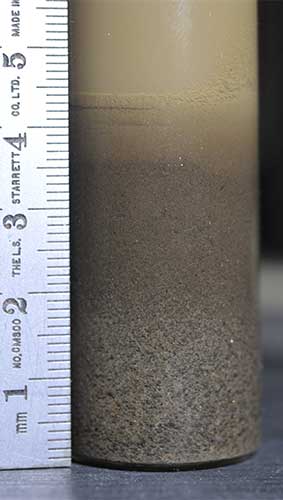 The area used to be a motorcycle racetrack with a stone surface; it was covered over with
20 cm of so-so soil when the house was built. At first I thought the added soil was clay, it
was so clumpy, water-retentive and hard to dig. But, when a soil texture check (at right)
indicated it was loam, I got a lab test. Loam it is, but previous owners had grossly overused
dolomitic limestone, high in water-clumping and phosphate-bonding magnesium. The problem has been
corrected by lowering pH to leach out excess magnesium, and by the addition of calcium (bone
meal) to counterbalance the remaining magnesium's effect on soil structure.
The area used to be a motorcycle racetrack with a stone surface; it was covered over with
20 cm of so-so soil when the house was built. At first I thought the added soil was clay, it
was so clumpy, water-retentive and hard to dig. But, when a soil texture check (at right)
indicated it was loam, I got a lab test. Loam it is, but previous owners had grossly overused
dolomitic limestone, high in water-clumping and phosphate-bonding magnesium. The problem has been
corrected by lowering pH to leach out excess magnesium, and by the addition of calcium (bone
meal) to counterbalance the remaining magnesium's effect on soil structure.
Soil management is zero tillage except for weeding and transplanting. Plant materials, including
tree leaves, flower petals etc., are left in place except as required to avoid disease. Natural
processes (including our non-native earthworms, which are plentiful) are relied on to transport
organic matter, phosphorus and sulphur throughout the growing layer.
| Front Garden before treatment (2006)
|
|---|
| area | 50 m2 |
| |
Remediation: 4 kg bonemeal (4-10-0, 9 kg/bag) per year until available phosphorus
reached an adequate level; 2 kg agricultural sulphur per year until pH reached 7.2 when
phosphorus is fully available.
Maintenance: 2 kg bonemeal per year.
Sulphur will be used as required to keep pH below 7.2 Bonemeal provides calcium (22%) to improve
soil structure. (Local labs don't test for it.)
|
| pH | 7.6 | high
|
| salts | 0.15 mS/cm | low (good)
|
| P | 30 ppm | low
|
| K | 200 ppm | adequate
|
| Mg | 300 ppm | high
|
| organic | 6.5% | adequate
|
Soil materials growers use for cacti & succulents
| Material
| Particle
size mm
| pH +
| Water *
absorption
| Notes
|
| Peat moss
| n/a
| 4.5
| 175%
| Fafard
|
| Fir bark
| 5-25
| 4.9
| 140%
| Fafard 'western bark'
|
| Qualisorb
| 1-5
| 5.3
| 120%
| calcined diatoms (silica)
|
| Turface
| 2-7
| 5.4
| 75%
| MVP, calcined clay
|
| Coffee grounds
| 0.1
| 5.7
| 290%
| fine grind
|
| Laterite
| 2-4
| 6.5
| 12%
| Aquarium Pharmaceuticals
|
| Topsoil
| n/a
| 6.6
| 250%
| Qualigrow
|
| Vermiculite
| 5
| 6.7
| 320%
| Perlite Canada Holiday, expanded mica, decomposes outdoors into thin plates 1-2mm in size with little absorption capacity, floats to the top when watering, asbestos free in Canada since 1995
|
| Cedar mulch
| n/a
| 6.8
| 550%
| Fafard
|
| Mix
| n/a
| 6.9
| 100%
| Fafard Cactus&Succulent Plant Potting Mix: peat moss, black earth, sand, Perlite, lime, fertilizer
|
| Perlite
| 3-10
| 7.6
| 190%
| Fafard, pumice/silica glass, looks like styrofoam, floats to the top when watering
|
| Chicken grit
| 5
| 7.8
| 10%
| Pestell Minerals, decomposes outdoors into powder, turkey grit same material 10mm size
|
| Sand
| 0.1-0.4
| 8.0
| 25%
| Bomix construction grade
|
| Tufa
| n/a
| 8.7
| 17%
|
|
| Marble
| 3-7
| 10.0
| 0
| Upper Canada Minerals size #1 white marble
|
+ equilibrium pH in distilled water
* oven dried dry weight; soaked for 1 hour, drained for 1 hour for wet weight
One top Ottawa grower uses 50% potting soil, 40% Turface, 10% coarse sand; another
50% Qualisorb, 50% topsoil; both mixes have high water retention.
On the web: Hubert Conlon (Cornell Cooperative Extension): 1 part
garden soil, 1 part sand and 1 part peat moss; Donna Kuroda (National Capital Cactus and Succulent
Society): 1 part potting soil, 1 part perlite; World of Succulents: 2 parts topsoil, 2 parts peat moss, 1 part coarse sand, 1 part perlite or crushed charcoal, 2 oz limestone & 2 oz bonemeal
per 15 l of mix. Most on the web agree that soil should fall apart after you wet it and give
it a squeeze, or that water should drain through pot in 15 s; most also agree that slightly
acidic pH is best, but that some lime is needed. A few growers even treat succulents as epiphytes
and pot in zero-soil zero-peat-moss bark mixes, but they are a small minority. The gap between
local growers and the more southern growers with sites on the web is remarkable.
After many experiments, I'm finding excellent success with 100% Turface, enlarging the bottom
holes of pots to 1 cm (with a diamond hole-drill) and adding bottom pads/legs to the pots so the
Turface is well ventilated through the hole. Once a week bottom soak until the Turface wets just
to the surface then drain. I've typically 40% sun at a window and indoor humidity 50-60%.
Wildlife
These are the wild creatures who have found shelter, food or water here so far (not just flown
overhead):
| Birds (42) | Other Animals (12)
|
|---|
American Crow
American Goldfinch
American Robin
Black-capped Chickadee
Blue Jay
Brown-headed Cowbird
Cedar Waxwing
Chipping Sparrow
Common Grackle
Common Redpoll
Common Starling
Dark-eyed Junco
Downy Woodpecker
Evening Grosbeak
Gray Catbird
Great Crested Flycatcher
Hairy Woodpecker
House Finch
House Sparrow
House Wren
Least Flycatcher
| |
Mallard
Mourning Dove
Northern Cardinal
Northern Oriole
Pileated Woodpecker
Red-breasted Nuthatch
Red-eyed Vireo
Red-winged Blackbird
Ring-billed Gull
Rock Dove
Rose-breasted Grosbeak
Ruby-throated Hummingbird
Pine Siskin
Sharp-shinned Hawk
Song Sparrow
Tree Sparrow
White-breasted Nuthatch
White-crowned Sparrow
White-throated Sparrow
Yellow Warbler
Yellow-rumped Warbler
| |
American Toad
Cottontail Rabbit
Eastern Chipmunk
Eastern Raccoon
Grey Squirrel
Groundhog
Leopard Frog
Meadow Vole
Painted Turtle
Red Squirrel
Short-tailed Shrew
Striped Skunk
Insects (335)
|
Weather
The average last spring frost is 6 May, the earliest 11 April 1998, the latest 9 June 1980.
Average first fall frost is 8 October, the earliest 6 September 1888, the latest 27 October 2011.
source: Rolf Campbell
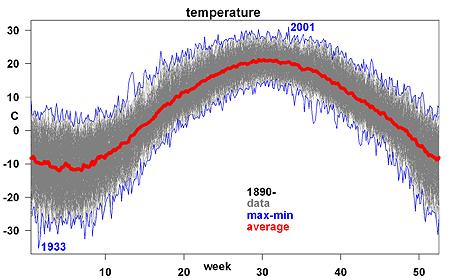
| 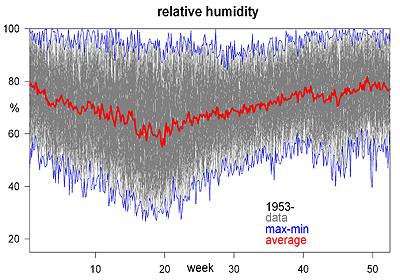
|
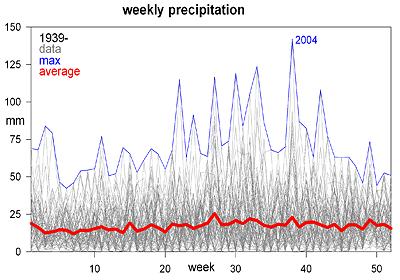
| 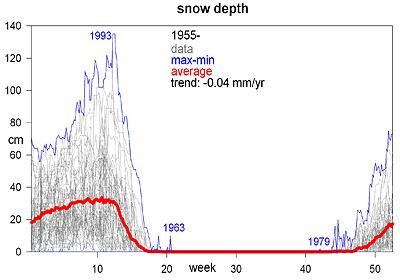
|
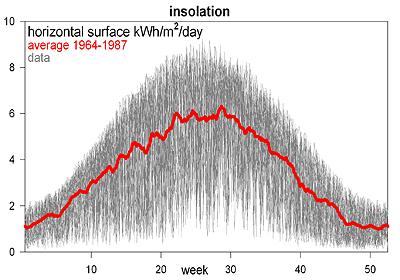
| 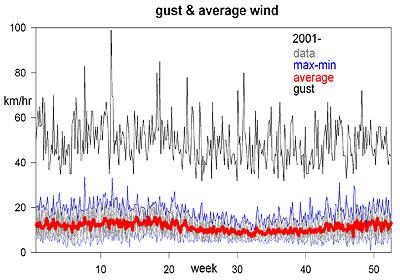
|
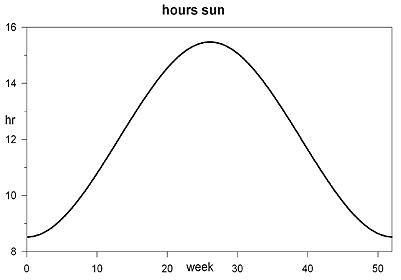
| 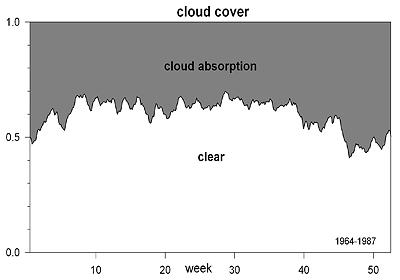
|
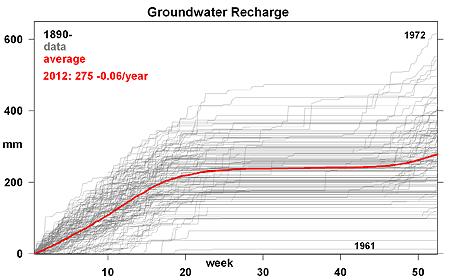
| 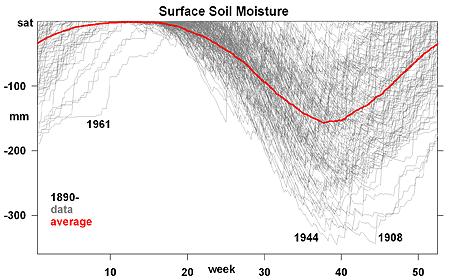
|
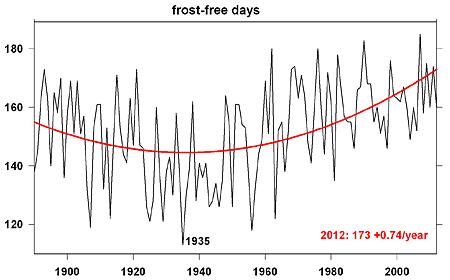
| 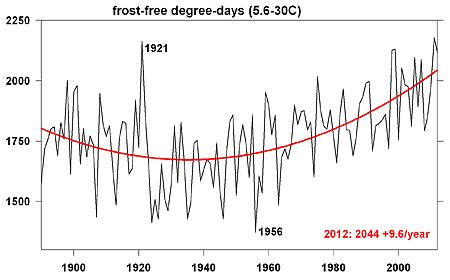
|
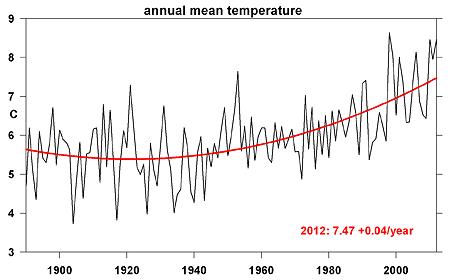
| 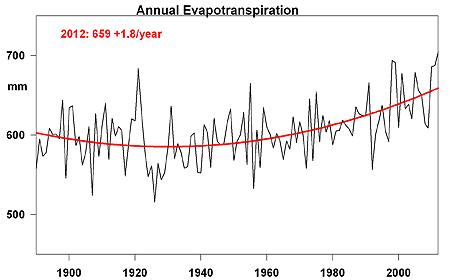
|
|
Urbanization did not reach the location of these measurements (CDA, 5 km NNW) until the
1930's; it didn't reach the YOW station (4 km south) until the 1970's. My detailed analysis
of the data from these two sites, combined with maps showing the extent of urban growth and energy
consumption data, indicates that roughly 60% of the CDA temperature increase since 1930 is due to
heat island effects from the growing city of Ottawa. The
purely statistical continent-wide analysis done by NASA, 56%, is
in surprisingly good agreement.
Mid-December 2011, the YOW station (1939-2011) was transferred to
NavCanada. The only Environment Canada station here is now
CDARCS (2001-), an automated unmanned system at the north end of the Central Experimental Farm.
Study of YOW, CDARCS and CDA records during their overlaps suggests:
Precipitation at CDA/CDARCS is statistically equal to that at YOW with no significant trend.
Temperature at CDA/CDARCS is 0.16 K higher than at YOW as of 2011; this difference
has been decreasing by 9.4±.3 mK per year since the 1970's.
Wind at YOW is higher than at CDARCS; gusts are 1.5x, average wind 1.2x; it's more
exposed.
Snow on Ground at CDARCS is about 85% that at YOW on average.
The solar insolation data was obtained at the National Research Council of Canada when I was there.
A temperature recorder was installed in my garden for 2012; its hourly reading average was equal
to CDARCS within statistical margins. The CDARCS temperature recorder is often taken off line;
comparison with my garden recorder shows that the CDARCS reading immediately prior to being taken
off line is usually anomalous and should be rejected. Incredibly, the station is maintained from
Toronto and North Bay, so errors accumulate until a technician travels from one of those locations
to fix it. There are technicians right next door at AgCanada who have been running their CDA
station since 1890, with greater reliability than CDARCS, but Environment Canada refuses to use
them.
|
John Sankey
other notes on nature studies
 2005: Moving in date was just before the ground was frozen solid. Some crocus bulbs were
quickly added to the front lawn and narcissus to the back. A few weeks later, a weak fork of the
Prunus virginiana in the front snapped off in an ice storm, leaving a gaping wound and seriously
weakening a second fork. The second fork was shortened by 1/3 to reduce stress on it. The tree
lost almost half its leaf area.
2005: Moving in date was just before the ground was frozen solid. Some crocus bulbs were
quickly added to the front lawn and narcissus to the back. A few weeks later, a weak fork of the
Prunus virginiana in the front snapped off in an ice storm, leaving a gaping wound and seriously
weakening a second fork. The second fork was shortened by 1/3 to reduce stress on it. The tree
lost almost half its leaf area.
 2006: Tree roots from the back third of the front lawn were cut off and dug out, which
helped a bit to balance the damaged Prunus top with its roots, and experiments with plants started.
A "free plants" sign and the offer of all the non-yellow flowers that appeared made friends with
neighbouring gardeners and resulted in many plants in exchange. The frantic blast of water sprouts
from the wounded tree were kept under control. A small preformed pond, several berry shrubs, and
bird feeders were added to the rear yard to attract birds and small mammals. A
2006: Tree roots from the back third of the front lawn were cut off and dug out, which
helped a bit to balance the damaged Prunus top with its roots, and experiments with plants started.
A "free plants" sign and the offer of all the non-yellow flowers that appeared made friends with
neighbouring gardeners and resulted in many plants in exchange. The frantic blast of water sprouts
from the wounded tree were kept under control. A small preformed pond, several berry shrubs, and
bird feeders were added to the rear yard to attract birds and small mammals. A
 2007: More plants were introduced for trial. Repairs continued on the Prunus to nurse it
back to health.
2007: More plants were introduced for trial. Repairs continued on the Prunus to nurse it
back to health.
 A meadow of native yellow-flowering plants was begun along the back fence.
A meadow of native yellow-flowering plants was begun along the back fence.
 2008: I and the plants were settled in enough that the front garden was expanded to fill
the middle third using material that had proven successful during the first two years. A low rock
curb that matched the new interlock driveway was installed to give shape to it. A new garden was
begun in a
2008: I and the plants were settled in enough that the front garden was expanded to fill
the middle third using material that had proven successful during the first two years. A low rock
curb that matched the new interlock driveway was installed to give shape to it. A new garden was
begun in a  2009: Conversion of the back fence meadow to a
2009: Conversion of the back fence meadow to a  2010: Early spring, a Magnolia 'Yellow Bird' was installed in the front garden to replace
the failed Syringa. During the summer, the rotting railway tie wall at the back was dug out and
replaced by interlocked stone, non-toxic and permanent. The back fence was repaired with help from
son Michael. After a lifetime of doing my own
2010: Early spring, a Magnolia 'Yellow Bird' was installed in the front garden to replace
the failed Syringa. During the summer, the rotting railway tie wall at the back was dug out and
replaced by interlocked stone, non-toxic and permanent. The back fence was repaired with help from
son Michael. After a lifetime of doing my own  2011: The Magnolia 'Yellow Bird' died over the winter, and was replaced by a M.'Sunburst'.
A height extension and vines were added to the top of the fence of the back
2011: The Magnolia 'Yellow Bird' died over the winter, and was replaced by a M.'Sunburst'.
A height extension and vines were added to the top of the fence of the back
 Limestone stepping stones were installed on the
Limestone stepping stones were installed on the  The last of the rear grass was replaced by a
The last of the rear grass was replaced by a  2012: 45 days after the first crocus was in bloom, the hyacinths were covered in wet snow.
They survived, so they'd belong here if they had stayed yellow. Unfortunately they got whiter each
year, so I gave them away. (3 week gaps between the last and 2nd-to-last spring frost
are common here; in 1957, the gap was over 4 weeks.) The weather upset Narcissus though,
only 10% of them bloomed. That was followed by a hot 26 June-22 July with no rain
whatsoever. (1995 was worse, and 1944 much worse; it too is part of weather here.) An
2012: 45 days after the first crocus was in bloom, the hyacinths were covered in wet snow.
They survived, so they'd belong here if they had stayed yellow. Unfortunately they got whiter each
year, so I gave them away. (3 week gaps between the last and 2nd-to-last spring frost
are common here; in 1957, the gap was over 4 weeks.) The weather upset Narcissus though,
only 10% of them bloomed. That was followed by a hot 26 June-22 July with no rain
whatsoever. (1995 was worse, and 1944 much worse; it too is part of weather here.) An
 2013: A dozen different alpine plants were added to the gravel garden for trial, and
experimental
2013: A dozen different alpine plants were added to the gravel garden for trial, and
experimental  2015: The frost penetration was much deeper than usual, freezing hundreds of pipes
throughout Ottawa, almost wiping out local ground nesting bees and small Hymenoptera, and almost
killing the Parthenocissus tricuspidata 'Robusta'. An Amelanchier alnifolia was added to
the front to become a replacement for the chokecherry.
2015: The frost penetration was much deeper than usual, freezing hundreds of pipes
throughout Ottawa, almost wiping out local ground nesting bees and small Hymenoptera, and almost
killing the Parthenocissus tricuspidata 'Robusta'. An Amelanchier alnifolia was added to
the front to become a replacement for the chokecherry.
 2016: The winter wiped out all the Aquilegia so it had to come up from seed, and set back
the Lilium, but other plants
thrived to compensate. The Forsythia 'Northern Gold' was donated to another gardener since it
grew too large and untidy for the site; a few Hemerocallis were donated to our first
neighbourhood Free Plant Exchange to focus on the happiest ones. The alpine pots were completed
along with trial acrylic tents for alpines that easily rot under snow, and experiments started
there with hardy cacti.
2016: The winter wiped out all the Aquilegia so it had to come up from seed, and set back
the Lilium, but other plants
thrived to compensate. The Forsythia 'Northern Gold' was donated to another gardener since it
grew too large and untidy for the site; a few Hemerocallis were donated to our first
neighbourhood Free Plant Exchange to focus on the happiest ones. The alpine pots were completed
along with trial acrylic tents for alpines that easily rot under snow, and experiments started
there with hardy cacti.
 2019: Marriage in March resulted in the appearance of non-yellow flowers, and a
rodent-protected vegetable/fruit garden and storage shed being added to the back garden.
Half the space in the protected garden is for hardy self-fertile berry shrubs and grape vines,
the rest for herbs and annual veggies.
2019: Marriage in March resulted in the appearance of non-yellow flowers, and a
rodent-protected vegetable/fruit garden and storage shed being added to the back garden.
Half the space in the protected garden is for hardy self-fertile berry shrubs and grape vines,
the rest for herbs and annual veggies.
 2021: The chokecherry reached the end of its life and was removed. The stump will be used
for ivy in a decorative pot. The front garden was awarded a city-wide prize:
2021: The chokecherry reached the end of its life and was removed. The stump will be used
for ivy in a decorative pot. The front garden was awarded a city-wide prize:




 The area used to be a motorcycle racetrack with a stone surface; it was covered over with
20 cm of so-so soil when the house was built. At first I thought the added soil was clay, it
was so clumpy, water-retentive and hard to dig. But, when a soil texture check (at right)
indicated it was loam, I got a lab test. Loam it is, but previous owners had grossly overused
dolomitic limestone, high in water-clumping and phosphate-bonding magnesium. The problem has been
corrected by lowering pH to leach out excess magnesium, and by the addition of calcium (bone
meal) to counterbalance the remaining magnesium's effect on soil structure.
The area used to be a motorcycle racetrack with a stone surface; it was covered over with
20 cm of so-so soil when the house was built. At first I thought the added soil was clay, it
was so clumpy, water-retentive and hard to dig. But, when a soil texture check (at right)
indicated it was loam, I got a lab test. Loam it is, but previous owners had grossly overused
dolomitic limestone, high in water-clumping and phosphate-bonding magnesium. The problem has been
corrected by lowering pH to leach out excess magnesium, and by the addition of calcium (bone
meal) to counterbalance the remaining magnesium's effect on soil structure.













